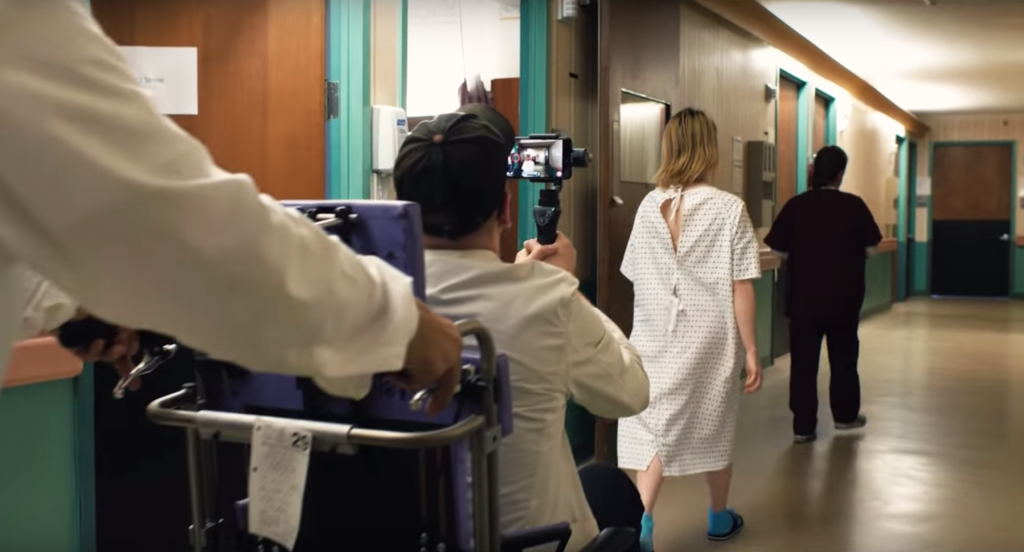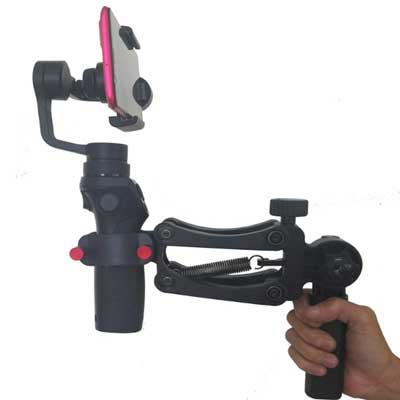Smartphone Gimbals: 5 Tips To Fix the Footstep Problem
Smartphone gimbals are great for getting the smoothest footage. They also give you some creative options not otherwise possible without a gimbal. Inbuilt stabilisation can’t help you have your camera swoop down from above your head, for example.
But often we are using the gimbal for simple tracking camera movements. We might be cruising along a street or following an actor walking or running. Gimbals are basically smaller, lighter, cheaper Steadicam stabilizers.
However, Steadicams are much better at removing that up and down bobbing motion you get when using an iphone gimbal. Well considering they cost around $5000, you would expect better performance than a $100 smartphone gimbal.
But there are ways to improve or remove this problem, without spending that kind of money.
1. Use a wheelchair
This is an old trick used by low budget filmmakers for decades. To save hiring expensive, bulky and time consuming tracks, filmmakers had the camera operator sit in a wheelchair. The someone would perform pushing duties to get nice smooth tracking shots.
You can see Steven Soderbergh using this technique when filming shot on iPhone Unsane.

In the image above, Soderbergh is using a DJI Osmo Mobile 2 whilst riding a wheelchair. The gimbal keeps the phone level, while the chair eliminates the bobbing from steps.
2. Walk Like a Ninja
The gimbal operator’s “ninja walk” has become a well-known method for reducing the bobbing motion. This technique involves keeping your knees bent and moves slowly, in a kind of half crouch. As if you’re creeping up on someone, about to spring on them.
Clearly, the slower and more cautiously you move, the less bobbing movements there will be. Taking smaller footsteps is also going to reduce the up and down movement. But if you want to walk briskly or even run, this method can’t really help you.
3. Tilt Handle Forward
If you tilt the handle slightly forward, it means your wrists and arms absorb some of the movement. When you hold the gimbal straight, the gimbal follows your body 100%. But when the handle is at an angle, your wrists act as another axis.
Now the arm of the gimbal becomes a shock absorbing spring. This is the cheapest way to create a 4-axis gimbal.
4. Add weight
Seems to be counterintuitive, a heavier gimbal will be less affected by the movement of your steps. Remember, your shoulders, elbows and wrists are all extra axis points. By adding weight, they come into play more.
Think about 2 people carrying a piano between them. That piano isn’t going to be bobbing up and down too much. Adding weight turns your body into a more effective shock absorber.
But considering one of the major benefits of using a smartphone and gimbal is the reduction in kit weight, this option might be a bit silly.
5. Use a 4th Axis device
Another option is to add another shock-absorbing device to your gimbal. The STARTRC 4th Axis stabilizer attaches to the handle of your gimbal. A simple extra axis and spring absorbs the up and down movement from your steps.
The device adds some extra bulk and weight to your filmmaker kit. Also, there’s less control over the gimbal and less comfort when holding it. But it might be a useful addition if you really want to smooth out your gimbal shots.
Check Price of 4th Axis Stabilizer on Amazon
One of our Facebook group members shared this video which he shot using a FreeVision Vilta M and a 4th axis stabilizer.
Use Warp Stabilizer (or similar)
Adobe Premiere Pro has an effect called Warp Stabilizer. This effect is pretty powerful, especially when you’re fixing small movements like footstep bobbing. Anything more shaky can lead to your final video looking… well… warped.
There’s plenty of settings to play with, however. Sometimes you just need to adjust the setting a bit to remove the warping. For example, reduce smoothness to about 5% and that should take out the warping effect.
The warping effect occurs when you are asking the software to do too much stabilizing. If your gimbal did 95% of the work already, then you only need the Warp Stabilizer to do the final 5%.
There’s alternative software, if you don’t have Premiere, including Final Cut Pro and iMovie.
Read more: Best Smartphone and iPhone Gimbals 2019
Eager to learn more?
Join our weekly newsletter featuring inspiring stories, no-budget filmmaking tips and comprehensive equipment reviews to help you turn your film projects into reality!
As an Amazon Associate I earn from qualifying purchases.
Simon Horrocks
Simon Horrocks is a screenwriter & filmmaker. His debut feature THIRD CONTACT was shot on a consumer camcorder and premiered at the BFI IMAX in 2013. His shot-on-smartphones sci-fi series SILENT EYE featured on Amazon Prime. He now runs a popular Patreon page which offers online courses for beginners, customised tips and more: www.patreon.com/SilentEye



This is gold and I like “Ninja Walk” better than my usual interpretive dance for camera or Thai chi references. Although I have used the neck strap at full extension and rigid bent arm tech a lot with older DVcameras (where the weight helps a lot to stabilise both my moves and the camera) particularly when shooting pov amongst actors and dancers on stage, I feel a bit too loose with the light weight of the mob. Maybe I should have another crack with the Osmo. Skate boards with a heavy weight make good dolly’s too… I had one I’d put in line skate slicks on for smoothness and speed and a big chuck of steel on top of a thick bit of neoprene with the camera mount bolted on top. Great for towing. The gimble action in the trucks can be really helpful in getting less rigid arcs. so enjoying your wisdom mate xkt
thanks Kate! Interesting experiences. You’re right, mobiles are quite light for filming, sometimes you need to add bulk – which is a bit ironic.
Hi Simon, nice site and great articles. As a very experienced TV cameraman there is a technique we use when handheld filming of people walking. We regularly use this method when walking backwards filming a reporter doing their piece to camera whilst walking. They are walking forward and we are right in front of them walking backwards. The method is to keep exactly the same distance from them during the shot and stay in step with them so the camera movement is in time with the talents movement. It hides the little bit of camera movement. It also works when doing those shots walking behind people.